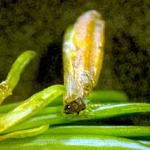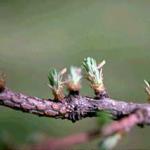Larch Casebearer
Order: Lepidoptera
Family: Coleophoridae
Coleophora laricella
Overview
The larch casebearer is native to Europe and was first detected in North America in Northampton, Massachusetts in the late 1800’s. Larch casebearer caterpillars spend their lives within a small, light brown, cigar-shaped case that they carry with them on the host plant. Larvae initiate feeding on the foliage of their host plants (Larix spp.; larch) when it is emerging from the bud. New needle tips can appear scorched or damage can proceed to complete defoliation, depending on population size. Repeated years of defoliation are extremely stressful for the host and may cause mortality. Usually, however, in New England, damage by this insect is limited to the aesthetic.
Host Plants
Host plants of the larch casebearer include but are not limited to: European larch (Larix decidua; (Hagen, 1886)), eastern larch (Larix laricina; (Ryan et al., 1987)), and western larch (Larix occidentalis (Denton, 1979; Tunnock & Ryan, 1985)).
Identification/Life Cycle
The larch casebearer is an introduced species from Europe. It was first reported in Northampton, Massachusetts in 1886 on planted European larch. Until the late 1950's, it was only found in the eastern United States. Following that time, it spread to the west.
The common name of this insect comes from the case constructed by the larva (caterpillar). This case allows the larva to be highly camouflaged, and detection of this insect on its host can be very difficult. Cases are formed by part of a mined-out larch needle that is lined with silk spun by the larva. Cases are the color of a dead needle and cigar-shaped. This case is then carried around on their backs for the remainder of the larval period.
The insect overwinters as a larva in its case, firmly attached to a branch or near the base of a bud or other woody locations of the host plant. Feeding by the larvae begins again in the spring. This begins as soon as foliage begins to appear. Fully grown larvae are approximately 6 mm in length. By late May or June, larvae complete their feeding and pupate within their case.
Adults emerge by June and early July and are winged to disperse (approximately between 700-1200 GDD). Adult moths have a wingspan of approximately 8 mm and are silvery/gray in color. Females lay tiny eggs that are attached to each needle, approximately 1 per needle. Eggs are described as reddish in color, and shaped like inverted jelly molds with 12-14 ridges when viewed with magnification. Upon hatching from the egg, larvae burrow directly into the host plant needles (approximately 2375 - 2805 GDD). Larvae start their feeding as needle miners for approximately 2 months. There is one generation per year.
Damage
While larch is a conifer that naturally loses its needles before the winter (unlike most conifers), the larch casebearer can sometimes cause its hosts to lose their needles prematurely. All species of North American larch as well as European species can be damaged by this insect. Damage may be severe, whether the host is found in a forest or a managed landscape. The needle tips will appear bleached or scorched and then turn brown. Feeding occurs on newly emerged foliage in the spring, and this is when the most conspicuous damage occurs. In heavy populations, trees may appear bronzed by mid-June. Heavy defoliation can slow both diameter growth and height growth of the host plant. If defoliation occurs during two or more consecutive years, host mortality may occur.
Managment Strategies:
The caterpillars of the larch casebearer are very cryptic and are only detectable to the trained eye, making monitoring for this insect a learning curve at first. New injury in the spring is obvious and should be monitored for and detected prior to it becoming severe. Scout plants as soon as new foliage emerges. Branches can be lightly shaken for the presence of adult moths during their flight period (approximately June and early July). Adults are grayish and have a wingspan of only 8 mm. Some private companies sell larch casebearer lures and traps for detection of the adults. Possible sex pheromones exist for this species and have been studied (McMillian and Borden, 1974; Priesner et al, 1982).
Cultural/Mechanical Management:
Cultural management options for the larch casebearer in ornamental landscapes are limited beyond choosing not to plant larch in areas where this insect is currently a problem. (For example, during a regional high population year.)
Biological Control/Natural Enemies:
There are natural enemies that reduce larch casebearer populations, however they are not always successful in preventing damage to host plants in managed landscapes. Some of these natural enemies are native and others were introduced as biological control agents of the larch casebearer. Parasites such as Agathis pumila, Bassus pumilus, and Chrysocharis laricinellae are important parasites. In some geographic locations, birds are also important predators of this insect. (Additionally, abiotic conditions such as sudden temperature change and late frosts are known to impact larch casebearer populations.)
Chemical Management:
Many active ingredients are labeled for use against larch casebearers in Massachusetts, including but not limited to: abamectin (NL), acephate (NL), azadirachtin (NL), Bacillus thuringiensis subsp. kurstaki, bifenthrin (NL), carbaryl (L), Chromobacterium subtsugae (NL), cyantraniliprole (NL), cyfluthrin (NL), deltamethrin (L), emamectin benzoate (L), flonicamid + cyclaniliprole (N), gamma-cyhalothrin (L), horticultural oil (L) (eggs), indoxacarb (L), lambda-cyhalothrin (L), malathion (L), permethrin (L), pyrethrins+piperonyl butoxide (L), spinetoram + sulfoxaflor (N), spinosad (NL), and tebufenozide (NL). Contact a Massachusetts licensed pesticide applicator for assistance.
Read and follow all label instructions for safety and proper use. If this information contradicts language on the label, follow the most up-to-date instructions on the product label. Always confirm that the site you wish to treat and the pest you wish to manage are on the label before using any pesticide. Active ingredients labeled "L" indicate some products containing the active ingredient are labeled for landscape uses on trees or shrubs. Active ingredients labeled "N" indicate some products containing the active ingredient are labeled for use in nurseries. Always confirm allowable uses on product labels. This active ingredient list is based on what was registered for use in Massachusetts at the time of publication. This information changes rapidly and may not be up to date. If you are viewing this information from another state, check with your local Extension Service and State Pesticide Program for local uses and regulations.
See the Professional Insect & Mite Management Guide for Woody Plants for more information about larch casebearer management on trees and shrubs.
References
Cold tolerance of the invasive larch casebearer and implications for invasion success (Ward et al., 2019)
MSU Extension: Insect pests are active on larch trees
US Forest Service: Larch Casebearer

